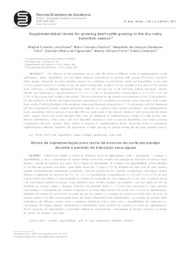Supplementation levels for growing beef cattle grazing in the dry-rainy transition season.
Supplementation levels for growing beef cattle grazing in the dry-rainy transition season.
Autoria: SALES, M. F. L.; PAULINO, M. F.; VALADARES FILHO, S. de C.; FIGUEIREDO, D. M. de; PORTO, M. O.; DETMANN, E.
Resumo: The objective of this experiment was to study the effects of different levels of supplementation on the performance, intake, digestibility, pH and rumen ammonia concentration in growing bulls grazing Brachiaria decumbens Stapf. pasture, during the dry-rainy transition season. For evaluation of performance, intake and digestibility, it was used 25 non-castrated steers at 11 months of age and initial average body weight of 270 kg, grouped in five plots of five animals each, following a completely randomized design. Each plot received one of the following feeding treatments: mineral mixture and supplement at the proportion of 0.5, 1.0, 1.5 and 2.0 kg/animal/day, corresponding to 0.18, 0.36, 0.54 and 0.72% of the average body weight of the animals. The area designated for the animals was constituted of five 2.0-ha paddocks. For the evaluation of the pH and rumen ammonia concentration, five crossbred non-castrated steers were used, with average body weight of 240 kg, fistulated in the esophagus, rumen and abomasum, disposed in a 5 × 5 Latin square, with five treatments and five experimental periods. Animal performance behaved in a positive linear manner according to the supplementation levels, responding with an increase of more than 80% on weight gains of the animals. Intakes of total and pasture dry matter (DM), organic matter and neutral detergent fiber were not influenced by supplementation. Intakes of crude protein, nonfibrous carbohydrates, ether extract and total digestible nutrients as well as nutrient digestibility and rumen ammonia concentration showed a positive linear pattern in response to supplementation levels. Increasing levels of concentrate supplementation influence positively the performance of bulls growing on pastures during the dry-rainy transition season.
Ano de publicação: 2011
Tipo de publicação: Artigo de periódico
Unidade: Embrapa Acre
Palavras-chave: Alimentación de ganado, Amoníaco ruminal, Amônia, Amônia ruminal, Brachiaria decumbens, Capim Brachiaria, Cebú, Consumo alimentar, Desempeño del crecimiento, Digestibilidad, Digestibilidade, Dry-rainy transition season, Gado Zebu, Gado de corte, Ganado de carne, Ganho de peso, Gramínea forrageira, Novilho de corte, Nutrición animal, Nutrição animal, Pastagem, Pastizales, Pastos forrajeros, Performance, Ph, Rumen ammonia, Suplemento alimentar, Suplementos dietéticos, Terneros, Transição seca-águas
Observações
1 - Por padrão são exibidas publicações dos últimos 20 anos. Para encontrar publicações mais antigas, configure o filtro ano de publicação, colocando o ano a partir do qual você deseja encontrar publicações. O filtro está na coluna da esquerda na busca acima.
2 - Para ler algumas publicações da Embrapa (apenas as que estão em formato ePub), é necessário ter, no celular ou computador, um desses softwares gratuitos. Sistemas Android: Google Play Livros; IOS: iBooks; Windows e Linux: software Calibre.
Acesse outras publicações
Acesse a Base de Dados da Pesquisa Agropecuária (BDPA) para consultar o acervo completo das bibliotecas da Embrapa.

